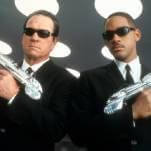If all the world’s a stage, and all the men and women merely players, then it stands to reason that “acting” is neither a craft nor an occupation, but rather a state of being. It’s certainly true for Stephanie (Stephanie Hayes), the elusive protagonist of Joe Denardo and Paul Felten’s Slow Machine, a struggling actress who is always performing regardless of whether she’s on the clock. She glides in and out of various environments, speaking in different accents and spinning detailed yarns about her background that are the stuff of exaggerated literary tragedy. It doesn’t seem to matter to Stephanie if people buy into her charade or not. The point is to build a character from within and bring them into the world so that they become real, a cross between quasi-Method research and an elaborate defense mechanism. It renders her entire reality slippery and sinister, but always filled with reckless excitement.
The same can be said about Slow Machine itself, a remarkably spirited film that, like the best of independent cinema, never allows its modest resources to stymie its ambition. It opens with Stephanie fleeing a New York apartment populated by obnoxious roommates to a house upstate, where musicians Jim (Ean Sheehy) and Eleanor (indie rocker Eleanor Friedberger, playing herself more or less) are recording new music. Denardo and Felten never clarify how Stephanie knows these people, because it’s not particularly important. What’s crucial is that she talks in a creaky Texas twang, and she’s on the run for as-yet- unexplained reasons. The film then flashes back weeks earlier to Stephanie, now speaking with a Swedish inflection, stumbling around drunk in the city. She wakes up in an undisclosed location—somewhere between a studio apartment and a black site—where a man named Gerard (Scott Shepherd), an NYPD counterterrorist agent, explains he brought her there for her own safety. It turns out he has seen her on stage because his fiancé is a fan of “so-called downtown theater.” From there, they form an unconventional friendship rooted in mutual suspicion as well as fascination with the other’s chosen profession.
These timelines eventually connect, but Slow Machine is less of a linear storyline and more of a series of interrelated vignettes—some more narratively on task than others. The film takes time to observe, whether it be Eleanor’s band stoically listening to a demo of a new track or scrutinizing Jim as he drunkenly propositions Stephanie after ensuring her safety. It also digresses to a lunch date between Stephanie and her friend Chloe (Chloë Sevigny, also pretty much playing herself), where the latter describes an ominous, but life-changing audition. An emotional through line eventually emerges, but Slow Machine never provides more answers than necessary. It’s not always clear whether any character is telling the truth about themselves, or even if Stephanie remains the exact same person over the course of the film. Slow Machine is more concerned with ambiance, immersing its audience in a sense of foreboding that’s balanced by a winning nonchalance. A general menace permeates the film in the form of paranoid intrigue and clandestine government forces, but it’s always offset with plenty of offhand irony and snarky one-liners like, “Brooklyn is a white toddler in a Run-DMC T-shirt.” For all its mysterious anxiety, Slow Machine goes down like a smooth whiskey.
Shot on beautiful 16mm over the course of four years, Slow Machine incorporates a diverse array of influences from multiple disciplines. The films of French director Jacques Rivette are its main thematic inspiration; Rivette’s occupation with secret conspiracies, prankster antics, and the porous nature of performance are all present in Slow Machine. Yet, the premise—theater actress crosses paths with secret agent under suspicious circumstances—has, per Felten, a distinct John Le Carré vibe. Its lo-fi aesthetic and punk sensibility recall an entire history of off-beat “alternative” art, especially ’80s American independent cinema and New York experimental theater collectives, like the Wooster Group and the work of Richard Foreman. The scenes between Hayes and Shepherd in particular feel like they’ve been tonally transported from a black box production, especially when they’re traipsing around Gerard’s top-secret hideout. Slow Machine also integrates literature (the title derives from a Philip Larkin poem and the film frequently cites his work) and music (we see Friedberger’s band record a version of “Your Word,” which appears on her 2016 album New View) into its milieu. In the true spirit of bohemia, Denardo and Felten adopt a scrappy, everything-and-the-kitchen-sink approach that treats all culture as both worthy of respect and grist for their own creative mill.
While every fragment in Slow Machine sports a woozy, partially surrealist tone that makes it compulsively watchable, the obvious risk with this method is incoherence—or worse, a hollow core. Slow Machine only reveals its intentions in its final scene, but when it does, they radiate backward, providing fuller shape to previously hazy sequences. There’s a long American tradition of reinvention, of trying on several masks—some better fitting than others—to discover one’s identity. Yet, the obvious hazard with presenting different selves to different people is losing yourself in the process, possibly leaving untold damage in your wake. Denardo and Felten use acting as a vehicle to illustrate the double-edged nature of an active imagination: Sometimes it’s productive, like when it’s used to invent a spooky bedtime story on the fly, and sometimes it’s perilous, like when it leaves you vulnerable to a paramilitary nightmare that swallows people whole. Slow Machine argues that a creative life inevitably offers multiple paths, but the consequences of one’s choices can never be forgotten.









































